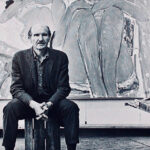Clyfford Still
Clyfford Still is one of the most significant figures in the Abstract Expressionist movement, known for his monumental canvases and bold use of color and texture. His work represents a profound exploration of abstraction, pushing the boundaries of artistic expression in the mid-20th century. Still’s contributions to the movement and his influence on subsequent generations of artists are immeasurable, making him a pivotal figure in the history of modern art.

Early Life and Education
Clyfford Still was born on November 30, 1904, in Grandin, North Dakota. His early years were spent in the rural environments of Washington state and Alberta, Canada, where his family moved frequently due to his father’s work in farming and ranching. These formative experiences in the rugged, open landscapes of the American West deeply influenced Still’s artistic vision, particularly his use of color and form.
Still showed an early interest in art and pursued formal education at Spokane University, where he studied from 1926 to 1927. He later attended the Art Students League in New York City and earned a Master of Fine Arts degree from Washington State College in 1935. During this period, Still was exposed to various artistic movements and developed a keen interest in European modernism, which would later inform his own work.
Transition to Abstraction
Still’s early works were primarily figurative, but by the 1940s, he began to transition towards abstraction. This shift was driven by his desire to express deeper emotional and psychological truths, moving away from representational art’s constraints. He sought to create a new visual language that could convey the raw, primal forces of existence.
By the mid-1940s, Still had developed his signature style, characterized by large, jagged fields of color and an emphasis on texture and scale. These works were created using a palette knife rather than a brush, giving them a rough, textured surface that added depth and dynamism. Still’s paintings often evoke geological formations or abstract landscapes, reflecting his deep connection to the natural world.
Notable Works
1. “PH-385” (1949)
“PH-385” is one of Still’s most iconic paintings, created during a crucial period in his career. The painting features a dominant field of deep, fiery red, punctuated by jagged, vertical streaks of black and yellow. The composition is both striking and intense, capturing the viewer’s attention with its bold use of color and dynamic forms.
This painting exemplifies Still’s ability to convey a sense of raw energy and emotional intensity through abstraction. The interplay of colors and the rough, textured surface create a sense of movement and depth, drawing the viewer into the painting. “PH-385” is a powerful testament to Still’s mastery of color and form, and it remains one of his most celebrated works.
2. “PH-1123” (1956)
“PH-1123” is another significant work that showcases Still’s mature style. The painting features a stark, white field interrupted by jagged, black forms that seem to slice through the canvas. This composition creates a sense of tension and contrast, highlighting Still’s interest in the interplay of light and dark.
The simplicity and austerity of “PH-1123” belies its complexity, as the painting’s rough texture and bold forms create a dynamic visual experience. This work reflects Still’s continued exploration of abstract forms and his ability to convey profound emotional and psychological depth through minimal means.
3. “1957-D No. 1” (1957)
“1957-D No. 1” is one of Still’s largest and most ambitious works, measuring over 9 feet in height. The painting features a vast, dark field punctuated by jagged, vertical streaks of vibrant red, yellow, and white. The scale of the work and its bold use of color create a sense of awe and contemplation, inviting viewers to immerse themselves in the painting.
This work exemplifies Still’s ability to create powerful, emotive compositions through abstraction. The interplay of colors and forms evokes a sense of primal energy and existential struggle, reflecting Still’s deep engagement with the human condition. “1957-D No. 1” is a monumental achievement and one of the most significant works in Still’s oeuvre.
Techniques and Innovations
Still’s approach to painting was characterized by his use of a palette knife to apply thick, textured layers of paint. This technique allowed him to create rough, uneven surfaces that added depth and dynamism to his works. He often worked on a large scale, creating monumental canvases that enveloped the viewer and demanded close engagement.
One of Still’s key innovations was his use of color. He often employed a limited palette, focusing on bold, contrasting colors to create a sense of tension and drama. His use of jagged, irregular forms and stark contrasts gave his paintings a sense of raw energy and emotional intensity, setting him apart from many of his contemporaries.
Personal Life and Influence
Still’s personal life was marked by his reclusiveness and his uncompromising approach to art. He was fiercely independent and often at odds with the commercial art world, refusing to conform to its expectations or to compromise his artistic vision. This independence allowed him to develop a unique and personal style, but it also meant that he was often isolated from the mainstream art community.
Despite these challenges, Still’s influence on the Abstract Expressionist movement and on subsequent generations of artists is profound. His emphasis on the emotional and psychological aspects of abstraction, as well as his innovative use of color and form, have had a lasting impact on the development of modern art. His work has been recognized and celebrated in major museums and collections around the world, including the Museum of Modern Art in New York and the San Francisco Museum of Modern Art.
Recognition and Legacy
Clyfford Still’s contributions to Abstract Expressionism and modern art are widely recognized and celebrated. His works are held in major museums and collections around the world, including the Museum of Modern Art in New York, the San Francisco Museum of Modern Art, and the Tate Modern in London. His influence can be seen in the work of subsequent generations of artists who continue to explore the possibilities of abstraction and emotional expression.
In 2011, the Clyfford Still Museum opened in Denver, Colorado, dedicated to preserving and showcasing Still’s work. The museum houses over 3,000 of his paintings, drawings, and prints, providing an unparalleled opportunity to study and appreciate his artistic legacy. The establishment of the museum reflects the growing recognition of Still’s importance in the history of modern art.
Conclusion
Clyfford Still was a pioneering figure in Abstract Expressionism, whose innovative use of color and form and focus on emotional and psychological expression left a lasting impact on modern art. Through his most notable works, such as “PH-385,” “PH-1123,” and “1957-D No. 1,” Still explored the possibilities of abstraction, creating powerful and evocative compositions that continue to inspire and challenge viewers. His legacy as a master of color fields and jagged forms endures, leaving an indelible mark on the art world.



